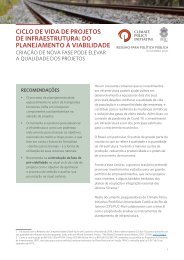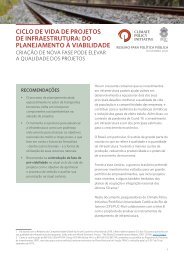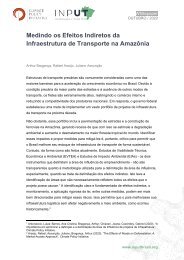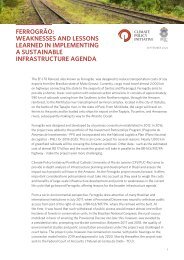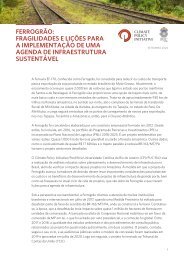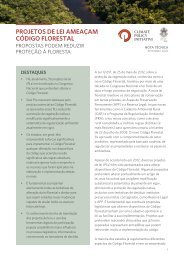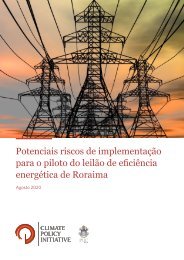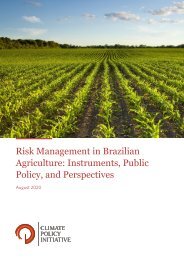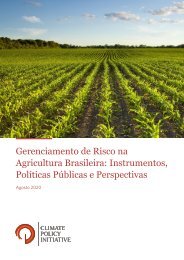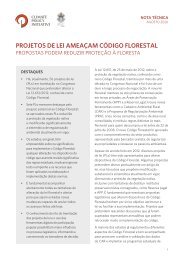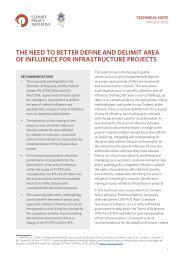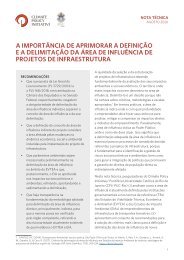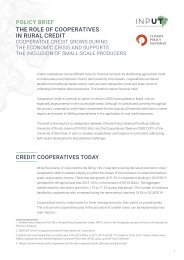The Impacts of Rural Credit on Agricultural Outcomes and Land Use
Create successful ePaper yourself
Turn your PDF publications into a flip-book with our unique Google optimized e-Paper software.
5<br />
Compulsory Resources are mostly associated with large l<strong>and</strong>holders. Figure 2 shows that, in the case<br />
<str<strong>on</strong>g>of</str<strong>on</strong>g> PRONAF, a 1% increase in credit supply leads to the increase in both producti<strong>on</strong> (0.19% in crop<br />
producti<strong>on</strong>, 0.02% in head <str<strong>on</strong>g>of</str<strong>on</strong>g> cattle) <strong>and</strong> productivity (0.10% in crop producti<strong>on</strong> per hectare <strong>and</strong> 0.14%<br />
in head <str<strong>on</strong>g>of</str<strong>on</strong>g> cattle per hectare). For PRONAMP, the impacts are not statistically significant <strong>and</strong> slightly<br />
negative for cattle producti<strong>on</strong>. <str<strong>on</strong>g>The</str<strong>on</strong>g> observed differences across small <strong>and</strong> medium farmers suggest that<br />
PRONAF is alleviating credit c<strong>on</strong>straints for small farmers, while medium farmers do not significantly<br />
change their producti<strong>on</strong> decisi<strong>on</strong>s with the increase in the availability <str<strong>on</strong>g>of</str<strong>on</strong>g> resources. This differential<br />
effect <str<strong>on</strong>g>of</str<strong>on</strong>g> PRONAMP might be because the target farmers are less financially c<strong>on</strong>strained.<br />
In the case <str<strong>on</strong>g>of</str<strong>on</strong>g> <str<strong>on</strong>g>Rural</str<strong>on</strong>g> Savings-Restricted, the increase in credit supply has a positive impact <strong>on</strong><br />
producti<strong>on</strong> (0.13% in crop <strong>and</strong> 0.04% in head <str<strong>on</strong>g>of</str<strong>on</strong>g> cattle) but no impact <strong>on</strong> l<strong>and</strong> productivity, which is<br />
a sign that the borrowers seem to use the funding to increase the extent <str<strong>on</strong>g>of</str<strong>on</strong>g> their activities rather than<br />
changing how they farm their l<strong>and</strong>. Finally, the results <str<strong>on</strong>g>of</str<strong>on</strong>g> Compulsory Resources point to an increase<br />
in producti<strong>on</strong> (0.04% in crops <strong>and</strong> 0.06% in head <str<strong>on</strong>g>of</str<strong>on</strong>g> cattle) <strong>and</strong> a slightly higher crop productivity<br />
(0.04%), but no impact <strong>on</strong> the measure <str<strong>on</strong>g>of</str<strong>on</strong>g> cattle productivity. Thus, the analysis <str<strong>on</strong>g>of</str<strong>on</strong>g> <str<strong>on</strong>g>Rural</str<strong>on</strong>g> Savings -<br />
Restricted <strong>and</strong> Compulsory Resources, which are funds primarily channeled to large farmers, seem to<br />
alleviate financial c<strong>on</strong>straints that prevent farmers from exp<strong>and</strong>ing their operati<strong>on</strong>s, but have much less<br />
impact <strong>on</strong> how they cultivate their l<strong>and</strong>. Notice that the <strong>on</strong>ly impact <strong>on</strong> productivity is much smaller<br />
than those observed in the case <str<strong>on</strong>g>of</str<strong>on</strong>g> PRONAF.<br />
<str<strong>on</strong>g>The</str<strong>on</strong>g> analysis <strong>on</strong> types <str<strong>on</strong>g>of</str<strong>on</strong>g> producers c<strong>on</strong>siders how the impact <str<strong>on</strong>g>of</str<strong>on</strong>g> credit varies according to the way<br />
farmers are organized (see Figure 3). Interestingly, rural credit affects producti<strong>on</strong> <strong>and</strong> productivity for<br />
farmers who operate as individuals, while those who operate as firms are not affected by the increased<br />
credit. <str<strong>on</strong>g>The</str<strong>on</strong>g>se results suggest that farming enterprises are not financially c<strong>on</strong>strained. Farmers who<br />
organize as individuals, <strong>on</strong> the other h<strong>and</strong>, experience both an increase in producti<strong>on</strong> (0.23% in crop<br />
<strong>and</strong> 0.10% in head <str<strong>on</strong>g>of</str<strong>on</strong>g> cattles) <strong>and</strong> productivity (0.15% in crop per hectare <strong>and</strong> 0.23% in head <str<strong>on</strong>g>of</str<strong>on</strong>g> cattle<br />
per hectare) for a 1% increase in credit supply.<br />
<str<strong>on</strong>g>The</str<strong>on</strong>g> analysis <strong>on</strong> uses <str<strong>on</strong>g>of</str<strong>on</strong>g> credit focuses <strong>on</strong> three categories: working capital, investment, <strong>and</strong> trade credit<br />
(see Figure 4). Working capital credit is short run, typically with a durati<strong>on</strong> <str<strong>on</strong>g>of</str<strong>on</strong>g> less than 12 m<strong>on</strong>ths,<br />
<strong>and</strong> used to fund operati<strong>on</strong>al expenditures (opex), while investment credit has a l<strong>on</strong>ger durati<strong>on</strong> <strong>and</strong><br />
is typically used for capital expenditures (capex). Trade credit is also short run, designed mostly to<br />
support farmers to better deal with price fluctuati<strong>on</strong>s <strong>and</strong> avoid selling their products in periods with<br />
low prices.<br />
<str<strong>on</strong>g>The</str<strong>on</strong>g> analysis <str<strong>on</strong>g>of</str<strong>on</strong>g> different credit uses reveals important differences. <str<strong>on</strong>g>The</str<strong>on</strong>g> impacts <str<strong>on</strong>g>of</str<strong>on</strong>g> working capital <strong>and</strong><br />
investment credit supply vary between crops <strong>and</strong> cattle ranching. In the case <str<strong>on</strong>g>of</str<strong>on</strong>g> crops, both working<br />
capital <strong>and</strong> investment credits affect crop producti<strong>on</strong> <strong>and</strong> crop productivity, suggesting these resources<br />
are supporting farmers to both exp<strong>and</strong> their business <strong>and</strong> change how they cultivate, improving yields.<br />
In the case <str<strong>on</strong>g>of</str<strong>on</strong>g> cattle ranching, credit does not induce an expansi<strong>on</strong> in producti<strong>on</strong>, but rather, an increase<br />
in productivity, especially in the case <str<strong>on</strong>g>of</str<strong>on</strong>g> investment (a 1% increase in credit for investment leads to<br />
a 0.19% increase in cattle productivity). As expected, trade credit does not have relevant impacts <strong>on</strong><br />
agricultural producti<strong>on</strong> or productivity.




